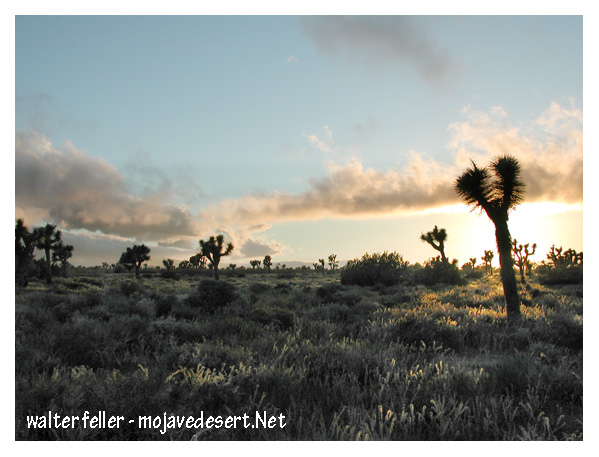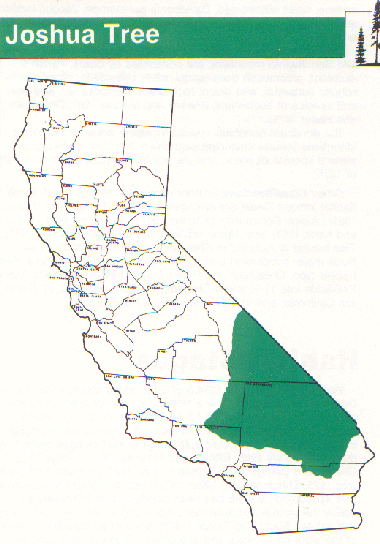Joshua Tree
(JST) Joshua Tree, Juniper Species, Mojave Yucca
Vegetation
Structure-- Joshua Tree habitats are characterized as open woodlands of widely scattered Joshua trees (Miller and Stebbins 1964, Cheatham and Haller 1975, Küchler 1977) with a low to more or less dense community of broad-leaved evergreen and deciduous shrubs (Küchler 1977) found in Desert Scrub habitats (Vasek and Barbour 1977). Joshua Tree habitats generally include little herbaceous understory (Cheatham and Haller 1975). Joshua trees usually are the only arborescent shrubs present (Cheatham and Haller 1975) however, in some areas, especially in the eastern Mojave Desert, other yuccas as well as scattered junipers and pinyons may coexist. Joshua trees, though very conspicuous, generally contribute little vegetation cover or stem density; thus, they should be regarded dominant only in terms of stature (Rowlands 1978). Large Joshua trees may exceed 6 m (20 ft) in height with maximum height ranging from 12 to 15 m (40 to 50 ft) (Jaeger 1957, Cheatham and Haller 1975, Thorne 1976, Küchler 1977).
Composition-- Joshua trees are rarely found as pure stands (Parker and Matyas 1981) but generally are associated with other overstory trees and shrubs. Coexisting overstory species include California juniper, Utah juniper, singleleaf pinyon, and Mojave yucca (Munz 1974, Cheatham and Haller 1975, Paysen et al. 1980, Parker and Matyas 1981). Many plants typical to Joshua tree habitats exist in adjacent Desert Scrub or Juniper habitats which Joshua trees may also inhabit (Paysen et al. 1980). Shrub species include big sagebrush, blackbrush, Nevada ephedra, California buckwheat, Cooper goldenbush, burrobush, creasotebush, Anderson's wolfberry, Cooper wolfberry, squawthorn, spiny menodora, Opuntia, bladdersage, longspine horsebrush, and Spanish bayonet (Shelford 1963, Bradley and Deacon 1967, Munz 1974, Cheatham and Haller 1975, Küchler 1977, Parker and Matyas 1981). Grasses and forbs include red brome, big galleta, bush muhly, and desert needlegrass (Bradley and Deacon 1967, Cheatham and Haller 1975).
Other Classifications-- Other names for Joshua Tree habitat include Joshua Tree Series (Paysen et al. 1980, Parker and Matyas 1981), Joshua Tree Woodland - 7.3 (Cheatham and Haller 1975), Joshua Tree Woodland - 29 (Munz and Keck 1970) (No Munz and Keck 1970 in Habitat Lit Cite. I used Munz and Keck 1973 for Lit Cite at end.), and Joshua Tree Scrub - 40 (Küchler 1977).
Habitat Stages
Vegetation Changes-- 1;2-3:S-M. After disturbance or invasion, Joshua Tree habitats slowly proceed through the successional sequence. Joshua trees of "typical form" (i.e., var. Jaegeriana) (P. G. Rowlands, pers. comm.) generally do not begin to branch until they reach a height of 1.5 to 1.8 m (5 to 6 ft) (Jaeger 1957). Duration of Stages-- The time necessary for Joshua tree habitats to progress through successional stages is not known but most likely relates to precipitation, fire, soil characteristics, and livestock use.
Biological Setting
Habitat-- Joshua Tree habitats generally occur at moderate elevations in the Mojave Desert between creosotebush scrub and pinyon-juniper woodlands (Vasek and Barbour 1977). At lower elevations, Joshua Trees intergrade with Desert Scrub (DSC), Alkali Scrub (ASC) (Cheatham and Haller 1975), and Desert Succulent Shrub (DSS). At higher elevations, Joshua trees interface with Pinyon-Juniper (PJN) (Cheatham and Haller 1975, Thorne 1976) and Sagebrush (SGB) (Thorne 1976). Joshua Tree habitats also may be adjacent to Desert Riparian (DRI) and Desert Wash (DSW) habitats within the elevational zone inhabited by Joshua Trees. Wildlife Considerations. Because Joshua Trees are the only sizable trees in many Joshua Tree habitats (Jaeger 1957), this species enhances the shrublike character of Desert Scrub habitat. Joshua Trees provide song perches, lookout posts, and nest sites for birds (e.g., ladder-backed woodpecker, cactus wren, Scott's oriole). The sharp spiny leaves provide protective havens for birds and lizards (Miller and Stebbins 1964). The desert night lizard, in particular, requires fallen Joshua tree branches, dead clumps of Joshua Trees or other yucca species, or other debris for shelter (Stebbins 1966)
Physical Setting
Joshua Tree habitats occur in broad valleys where soils are deep, on alluvial or rocky slopes, and on pediments with minimal runoff surrounding desert mountains and mesas (Webber 1953, Jaeger 1957, Munz 1974, Thorne 1976, Parker and Matyas 1981, Turner 1982). Soils must be well drained but may vary considerably in other characteristics. Typical soils may be loose, porous, loamy, sandy, or fine gravelly (Webber 1953, Jaeger 1957, Thorne 1976, Turner 1982) and are more permeable with lower salt concentrations and more organic matter than other soils, especially those at lower elevations (Bradley and Deacon 1967). Hot, dry summers and cool to cold, moist winters are characteristic of areas occupied by Joshua trees and their associates. Highest July temperatures range between 28 to 44 C (82 to 111 F) and lowest January temperatures range between 9 and 3 C (16 and 37 F) (Rowlands et al. 1982, P. G. Rowlands pers. comm.). Most precipitation is in winter, though summer rainfall occurs, especially in the eastern Mojave Desert. Total precipitation ranges from 11 to 30 cm (4 to 12 in) per year and potential evapotranspiration is from 2 to 15 times as great as precipitation (Rowlands et al. 1982, P. G. Rowlands pers. comm.). Slope aspect influences the elevations at which Joshua trees grow. In Nevada, Joshua trees generally occupy north-facing slopes at elevations between 1280 and 1830 m (4200 and 6000 ft), but may be found down to 1190 m (3900 ft). In contrast, Joshua trees on south-facing slopes may be found up to 1980 m (6500 ft) (Bradley and Deacon 1967).
Distribution
The elevational distribution of Joshua Tree habitats varies from 750 to 2300 m (2500 to 7500 ft) (Munz 1974, Cheatham and Haller 1975, Thorne 1976, Rowlands et al. 1982, P. G. Rowlands pers. comm.) but maximum development occurs above 1000 m (3300 ft) (Shelford 1963). Joshua Tree habitats generally are found at most points on the periphery of the Mojave Desert; however, these habitats do not occur where the Mojave Desert contacts Sonoran Desert scrub habitats (Turner 1982).
California Wildlife Habitat Relationships System, California Department of Fish and Game, California Interagency Wildlife Task Group, Joshua Tree - William F. Laudenslayer Jr.

The Adventurous Yucca - Natural Science: Joshua Tree
As you look at this wide expanse of Joshua trees (Yucca brevifolia) you can see how the notion O'Kane wrote about might have originated. ...
A Distinguished Yucca - Natural Science: Joshua Tree
If you are not familiar with the desert, you may not yet distinguish the Joshua tree (Yucca brevifolia) and the Mojave Yucca (Yucca schidigera). ...
Hidden Valley: A Transition Zone
Looking around the Hidden Valley you can see a number of other plants species, such as the Joshua tree (Yucca brevifolia), blackbrush (Coleogyne ...
Joshua Tree California
Yucca Brevifolia Joshua Tree Chamber of Commerce 61325 Twentynine Palms Highway PO Box 600 Joshua Tree, California 92252 760-366-3723 ...
Mojave Yucca: Desert Wash: Indian Cove
Growing abundantly in the high desert, this yucca resembles its larger relative, the Joshua tree (yucca brevifolia) which usually occurs at higher ...
Dead Joshua Trees
The Joshua tree, Yucca brevifolia, living or dead, has a large role in the Mojave ecology. Numerous creatures shelter in the leaves and thatch, ...
Joshua Tree - Tree of Life
The Joshua tree, (yucca brevifolia), grows wild primarily in the Mojave Desert. It has adapted to reduced rainfall by spreading its roots in a dense, ...
Desert Ecosystems
Desert Ecosystems in Joshua Tree National Park. ... There are two types of desert within Joshua Tree National Park: the Mojave and the Colorado. ...